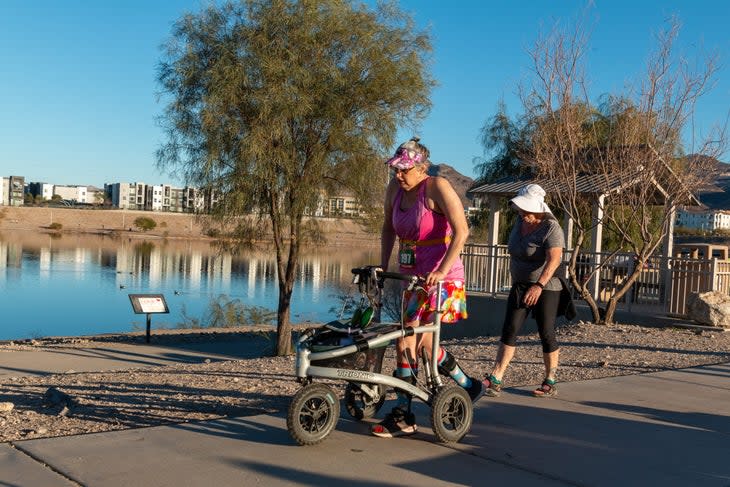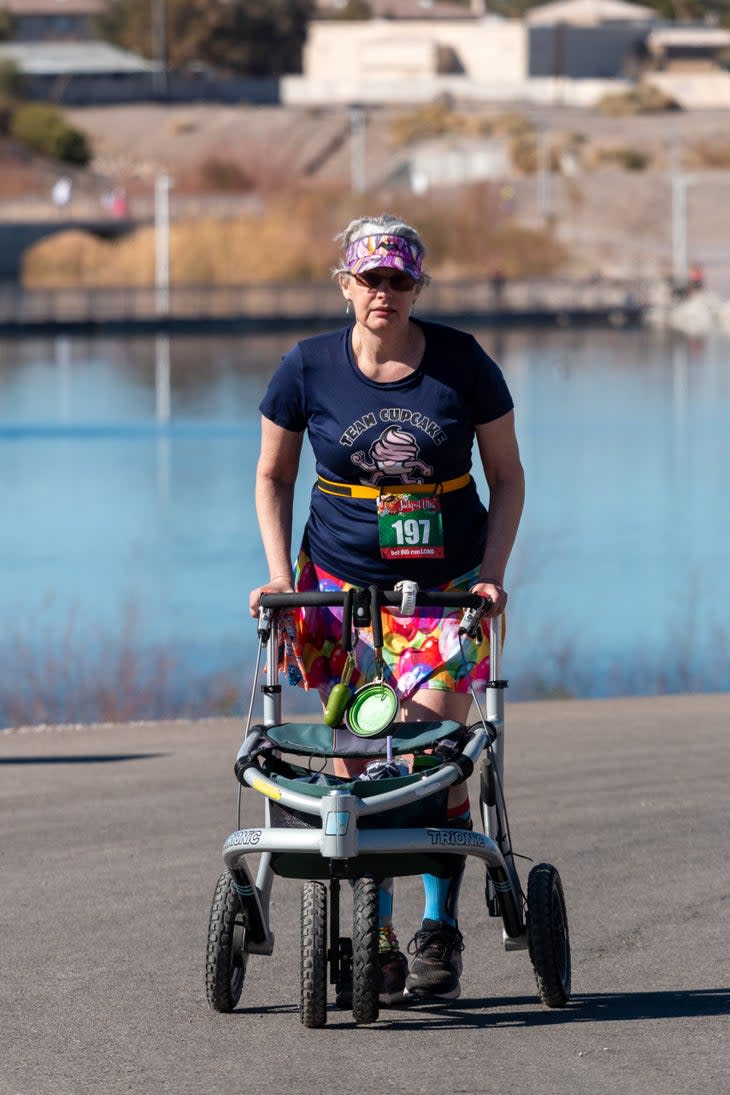Muscular Dystrophy Won’t Stop Jane Herzog from Running Ultras
This article originally appeared on Trail Runner
Jane Herzog was out on another loop in the Las Vegas desert this past February. Runner after runner went by her and her walker as they completed their respective Jackpot Ultra Running Festival events. Occasionally, someone would comment.
They're the same remarks she hears whenever she's out logging miles near her home in Washington state: "you're an inspiration," "you're so brave," "you're the reason I'm still going."
"It annoys me," Herzog said. "I don't want to be an inspiration. I don't want this disease. I've been a back-of-the-pack person. Now, I'm visible to everyone."
Muscular dystrophy has forced the 58-year-old to adapt her running around her muscles' changing abilities. Currently, that requires a high-tech Trionic Veloped walker, which is what catches eyes at every race.
She's visible when she's racing, but Herzog says people lose sight of who she really is.
"I want to be a regular person out there," Herzog said. "I want people to notice me and not the walker. I don't even pay attention to its existence after a while out there and I need it to stay upright. I want them to just notice Jane."
That person is a certified Marathon Maniac and has completed marathons in all 50 states. That includes 26.2s both before and after her diagnosis (30 of them with the walker). She ran her first 100 miler with the walker, and used it when completing double crossings at the Great Virtual Race Across Tennessee (GVRAT), a virtual race that gives runners four months to log as many miles back and forth across Tennessee.
The miles logged in her lifetime keep rising more and more even if her life has changed drastically over recent years. All she knows it she will always find a way to keep going.
"She has been a runner all her life," said her husband, Ray Shaw. "She can't just up and quit. Some people would, but not Jane."
RELATED: Three Ways To Crush Your First 100 Miler
Finding a Way
Herzog was slowing down. She had around 15 marathons left to complete her 50-state goal, and the then-51-year-old felt she had the ability to maintain her 8-minute paces.
When 10- to 12-minute miles became the fastest she could sustain, she thought it might simply be the effects of getting older. But there was this tired feeling, too, that wouldn't go away. It was like her body was saying, "no, not anymore."
An injury stopped her running completely. Going downhill on a run, Herzog slid down on some rocks and dirt. While attempting to stop, her femur jammed through her hip socket. The bone in the hop was cracked all the way through.
It took time for the injury to heal, but as it did, the atrophy in her leg persisted. This uimately led to a gazillion tests (nervous system, muscles biopsy, MRI) and doctor appointments over a year or more until she was finally diagnosed via a DNA test.
"I had muscular dystrophy," she said. "I apparently had always had it. No one else in my family has it, so I think it's because I'm the middle child. The middle child always gets screwed."
Muscular dystrophy has many variations, but it primarily causes progressive weakness and loss of muscle mass. The condition can appear in childhood, or in some cases, like Herzog's, during adulthood.
Herzog's specific condition is facioscapulohumeral muscular dystrophy (FSHD). Her body produces a protein that kills her muscles instead of creating new ones.
The diagnosis was disheartening, but Herzog was determined to continue moving. She had goals. She had to finish her 50 marathons, which she did by focusing on races with longer cutoffs. As she neared the completion of that goal, she thought about the next one. Compelled like many runners, she wanted to go farther.
"I kept thinking, now what?" she said. "I always wanted to do a 100 miler. I just needed to figure out how."

"There's always a way"
While exercise has kept Herzog mentally and physically happy, the jury is out on whether so much exercise is beneficial or harmful in individuals with this form of muscular dystrophy. Exercise breaks down her muscles, and over the years, she has lost more of them.
"I don't have the ankle and foot muscles to push off," Herzog said. "I don't have hamstrings and my quads are halfway gone. For one leg, I don't even have a calf muscle. It's not just me not being able to push through. I still get emotional over it."
"My doctors encourage me to keep going," she added, "and I'm all for it."
Her balance is off these days. She can't push off her toes like she used to. She needs assistance when walking. As her gait and techniques changed, she adjusted. First, trekking poles helped her keep her balance. When that started to go, she tried her daughter's baby jogger, but she couldn't manage inclines. She needed a more advanced walker, beyond the standard ones available in the United States.
A FSHD Facebook support group yielded an answer. There was a brand, Trionic, that made an advanced walker called the Veloped. Like many medical devices, it was not covered by insurance and cost around $1,500.
She also needed special braces for her feet, too, which cost $2,000 each. When she found medical providers who were serious about helping her find a unique solution, it took several iterations to get the races correct. As her legs change, she needs adjustments to her braces, or new ones altogether.
"The whole experience can, at times, be disheartening and bitterly frustrating," said Herzog's friend and longtime running partner, Tracy Brown. "She has not settled for something, a brace, a walker, that will not help her to the extent that she needs help. This shows Jane’s inner strength, but I wish that Jane did not have to constantly use that inner strength. She suffers and has to fight to get what she needs."
The price tag is hefty, but the payoff is priceless.
"There's always modifications to things you can do," Herzog said. "It won't be the same. I don't get the same runner's high, but it's similar to the rush from what you used to do. Your attitude makes the difference."
RELATED: From Traumatic Brain Injury To 100 Miles
Hitting the Jackpot
It's incredible how one piece can change the whole puzzle. With the Veloped, Herzog has completed 30 marathons. She tackled her first 100 miler at A Race for the Ages in Tennessee in 2018 and again in 2021. Between those finishes, she completed GVRAT twice, going double the required distance for a double crossing distinction. Then, she ran Jackpot this past February. Her aim was to do 102 miles during the 72-hour race.
"We used to go out and do a marathon Saturday and a marathon Sunday and think nothing of it," Shaw said. "She'd go out and do 50Ks and other races. Now, it takes all day to do a marathon, but she gets it done."
Working full-time as a controller doing payroll and finding flat races with long cutoffs means that getting to a start line is a challenge in itself. Because Herzog needs time to rest during a 100-mile effort, she usually looks for events with 72-hour cutoffs like A Race for the Ages and Jackpot.

"My normal walking now is 18- to 22-minute miles; 50 miles takes me around 24 hours," she said. "When I'm tired, I need to lay down for a couple hours, and most races will time out if you're doing walking paces."
At Jackpot, she completed about 45 miles in her first 24 hours. Her goal was to reach a total of 75 miles by the 48-hour mark because "25 miles left didn't sound too bad" for the last 24 hours. Herzog took some breaks during the first 24. During the second night, her husband encouraged her to get a few hours of sleep before heading back out. He would get some sleep, too.
That was around 10 p.m., a day and a half into the race. At midnight, she woke up and continued moving with Shaw still asleep. By the next time she stopped, she had reached 76 miles and headed in to rest before the final push with 24 hours to go.
"I crawled into the tent. It was cold that night," she said. "An hour later, my husband was poking me to see if I was ever going to get up and get moving. He didn't know I was out all night."
Refreshed nonetheless after the short break, Herzog got back out there. She watched Camille Herron break her 100-mile world record and kept moving. Around 1 a.m. Sunday morning, she walked across the line, finishing with 102 miles. There was time to keep going, but she had accomplished her goal.
"Everyone goes through the pain and mental dark places in ultras," Herzog said. "I'm no different than the blind athletes I was running with or the other runners. We all go to a dark place and find our way out. That's why we do this."
RELATED: A Training Plan To Run 100 Miles
What Comes Next
A couple of weeks after Jackpot, Herzog's hands were still numb, a product of having to hold herself up on the walker for all 102 miles. But her feet ended up in good shape post-race. Normally, the plastic braces rub against her foot inside her shoes. Putting a gaiter on inside her right shoe seemed to do the trick this time.
"People really don't know what she goes through to do what she does on a race course," Brown said. "
It's all part of the process, Herzog said. Whether testing out strollers, trying new wheels on her Veloped, or not being able to write legibly for a week because she held herself up for 50+ hours over a weekend, the puzzle in finding a way to keep going isn't easy. But the alternative is not being out there at all.
"I'm not going to do that," Herzog said. "It's fun to say this disease hasn't taken over me yet. I know that there's still a super high probability I'll be in a wheelchair in the not too far future. Until then, I'm going to do my life, and I'm going to keep carrying on."
This means more GVRAT crossings this summer, a possible return to A Race for the Ages if her work schedule allows it, and racking up as many miles as she can, for as long as she can.
"I get why people are inspired; it's the awe," Shaw said. "Going out there and looking after it rains to see a beautiful rainbow. That's what it's like when you see her come in an upright position across the finish line. It's a glorious feeling. She makes you cry. She refuses to quit."
For exclusive access to all of our fitness, gear, adventure, and travel stories, plus discounts on trips, events, and gear, sign up for Outside+ today.

